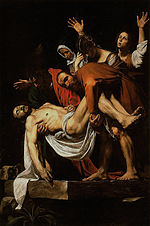
Back Hipótesis del desvanecimiento Spanish Théorie de l'évanouissement French Teoria do desmaio Portuguese
| Part of a series on |
| Death and Resurrection of Jesus |
|---|
 |
|
Portals: |
The swoon hypothesis is any of a number of ideas that aim to explain the resurrection of Jesus, proposing that Jesus did not die on the cross, but merely fell unconscious ("swooned"), and was later revived in the tomb.[1] According to the proponents of the swoon hypothesis, the appearances of the risen Jesus to his disciples following his resurrection from the dead were merely perceived to be resurrection appearances by his followers; proponents of the swoon hypothesis believe that Jesus allegedly fell unconscious ("swooned") on the cross, survived the crucifixion, and then regained enough strength to appear before them while he was still alive.[1]
This and other similar theories about the resurrection of Jesus and witnesses to his resurrection became popular in the Western world after they were first proposed by some 18th–19th century Western authors and philosophers, including Oscar Wilde and Friedrich Schleiermacher; however, since the last decade of the 19th century, all of them have been discarded as baseless and unacceptable by the majority of biblical scholars and academics.[1] This 200-year-old hypothesis continues to be the subject of debate in popular circles, but the biblical scholarly literature considers it uncontroversial that Jesus died during his crucifixion.[2]
- ^ a b c Stevens, Jennifer (2010). "The Fifth Gospel of Oscar Wilde". The Historical Jesus and the Literary Imagination, 1860–1920. Cambridge and Liverpool: Liverpool University Press. p. 160. doi:10.5949/UPO9781846316159.006. ISBN 9781846316159. JSTOR j.ctt5vjbx8.9.
Theories proposing that Christ survived the crucifixion and regained enough strength to appear before his disciples were several and varied. [...] While by the last decade of the century such theories were no longer regarded as academically respectable by the theological establishment, those set on discrediting the Gospels continued to exploit them with some abandon.
- ^ Bergeron, Joseph W. (April 2012). "The crucifixion of Jesus: Review of hypothesized mechanisms of death and implications of shock and trauma-induced coagulopathy". Journal of Forensic and Legal Medicine. 19 (3). Elsevier on behalf of the Faculty of Forensic and Legal Medicine: 113–116. doi:10.1016/j.jflm.2011.06.001. ISSN 1878-7487. OCLC 612913525. PMID 22390994. S2CID 8094030.